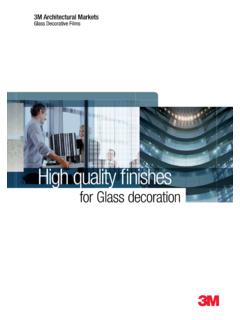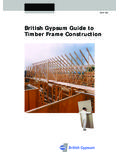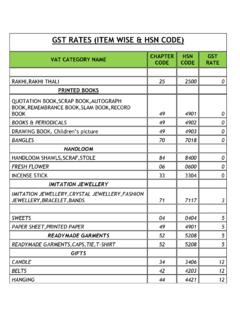Transcription of DAACS Cataloging Manual: Buttons
1 DAACS Cataloging manual : Buttons by Jennifer Aultman and Kate Grillo October 2003 Updated June 2012 2 DAACS Cataloging manual : Buttons 3 1. MAIN button TABLE .. 3 Artifact 3 Completeness .. 3 Manufacturing Technique .. 3 button Type .. 4 button Shape .. 6 button Material .. 6 button Material, Face .. 7 Manufacturing Technique, Face .. 7 button 7 button Eye .. 7 button Shank Style .. 8 button Shank Material .. 9 button Shank Condition .. 9 button Metal Color .. 10 button Back Stamp .. 10 2. button DECORATION .. 10 Decorative Technique .. 10 Jewel/Inlay Material .. 11 Decorative Technique Color .. 11 Decorative Motif .. 11 3. button CONDITION .. 11 Burned .. 11 Conservation .. 11 Post-Manufacturing Modification .. 11 4. button MEASUREMENTS .. 12 5. EXAMPLES FOR Cataloging VARIOUS button TYPES .. 12 Bone Buttons .
2 12 Ceramic 12 Glass Buttons .. 12 Metal Buttons .. 13 button 13 REFERENCES .. 14 3 Introduction button terminology is generally not as standardized or as well known as terminology for other artifact classes, such as ceramics. Therefore, a great deal of what follows is simple definition of terms found in the button table. The button table for DAACS was produced in conjunction with Barbara Heath and Heather Olsen of Poplar Forest. Their input is greatly appreciated. 1. Main button Table Artifact Count Do not batch Buttons . Completeness Choose Complete, Incomplete, or Shank Only. Manufacturing Technique Manufacturing Technique refers to the main manufacturing technique of the button . For one-piece Buttons , for example, this is usually Cast or Stamped. For two-piece Buttons , we are using Manufacturing Technique in reference to the main button part, not the button face.
3 Manufacturing Technique, Face refers to the manufacturing technique of the button face. Manufacturing Technique Description Cast Molten metal was poured into a button mold and allowed to harden. The button would have characteristic mold seams most likely on the back of the button and possibly the eye. Some Buttons had cast eyes (with mold marks) and others were cast with an iron or brass wire shank placed into the mold. Hinks (1988:60) notes that most cast Buttons from the early 18th century are pewter, but by the mid-18th century large numbers of cast brass and copper ( copper alloy) Buttons were produced. Cut/Carved Used for bone, ivory, shell, wood, and other organic materials that are cut or carved by hand or machine. Drawn Most commonly applies to drawn glass Buttons and wire metal Buttons . For instance, metal rings that are used as button forms for covered Buttons , such as crocheted Buttons , are usually drawn wire.
4 Drawn glass Buttons are made in much the same way as drawn glass beads, where a long tube of glass is blown out, stretched (drawn), and then cut. 4 Hollow cast The face and back are cast as one piece around a separate, often iron, shank. Two holes are present in the back to allow internal gases to escape during casting. Used for brass or pewter Buttons . Most common in the first half of the 18th century (Hinks 1988:56). Molded Used primarily for glass Buttons that are poured in liquid form into a mold and allowed to harden. Prosser Molded Highly compressed, heated ceramic Buttons . Generally date after 1840 (Sprague 2002:111). In DAACS , the material type for Prosser molded Buttons is Porcelain. Spun Back Cast button was cast in a mold, usually with the eye cast in place. After casting, the button was placed in a chuck and spun by the lathe. A tool was used to cut the back of the button to remove the mold seams and smooth the surface.
5 This type is characterized by the concentric circles that can often be seen on the button back. The eye was often a wire cast in place with a blob of metal, later lathe-finished which created a cone-like shape to the shank (described below). Stamped Metal discs stamped out of large sheets of metal, creating a very thin and uniform button . Stamped Buttons are almost always copper alloy, such as brass, as tin alloys are too soft and brittle to be rolled out into thin sheets and stamped. Solder was used to attach wire shanks to stamped Buttons . Unidentifiable Use when the manufacturing technique is unidentifiable. Wound Used for glass Buttons that are wound from long threads of glass. button Type 1 Piece: These Buttons are made from a single material, such as wood, bone, horn, glass, etc. The distinguishing factor of one-piece Buttons is that they are constructed from one material, as only one part.
6 These Buttons will have a height-to-diameter ratio of or less. Note: In DAACS , flat metal Buttons should not be cataloged as one-piece. There is a separate button Type, Flat Disc, to describe flat, metal one-piece Buttons . Also see 1 Piece, semi-domed and 1 Piece, domed. 1 Piece, domed: These Buttons resemble one-piece Buttons , but are domed instead of flat. For example, cast one-piece metal Buttons are often 1 Piece, domed. A domed button will have a height-to-diameter ratio of or greater. 1 Piece, semi-domed: These one-piece Buttons have a convex front, but lack the exaggerated arch of domed Buttons . A semi-domed button will have a height-to-diameter ratio between and 2 Piece: These Buttons consist of separate faces and backs that were brazed/soldered or crimped together. The face and back were often made of different materials. Most common 5 in brass Buttons , although found in pewter as well.
7 These Buttons will have a height-to-diameter ratio of or less. Also see 2 Piece, semi-domed and 2 Piece, domed. 2 Piece, domed: Made just like other two-piece Buttons , but with a domed face (and possibly a domed back). A domed button will have a height-to-diameter ratio of or greater. 2 Piece, semi-domed: These Buttons consist of a separate face and back piece brazed/soldered or crimped together. The face and back can be different materials. They have convex fronts, but lack the exaggerated arch of domed Buttons . A semi-domed button will have a height-to-diameter ratio between and 3 Piece, semi-domed: These Buttons consist of a (usually stamped) face, a back and a separate band or mid-section that joins the two pieces. They are brazed/soldered or crimped together. They have convex fronts, but lack the exaggerated arch of domed Buttons . A semi-domed button will have a height-to-diameter ratio between and Army General Staff button 1832-1902 The Big Book of Buttons Hughes and Lester, 1981 Blank/Mold: A Blank/Mold is a bone or wood button with either zero holes or one hole.
8 The single hole was a product of manufacturing, when these Buttons were cut with a lathe or a carpenter s brace and bit (Hinks 1988:67). They could be used as the backs to stamped metal Buttons , the supporting disc for cloth Buttons , or more holes could be drilled in them to make simple, one-piece bone or wooden Buttons (ibid). Collar button 6 FD concave back: These are flat disc Buttons with concave backs. Note that these Buttons do not have to be as domed as 1 piece, domed Buttons , but can be only slightly concave. FD convex back: These are flat disc Buttons with convex backs. Note that the front of the button is often concave. Flat Disc: DAACS describes flat, metal one-piece Buttons as Flat Disc Buttons . These Buttons are flat discs with shanks either cast as part of the button or soldered onto the back. See also FD concave back.
9 Ring: These Buttons have a cloth or crocheted covering structured around a thin metal ring. The metal ring is often the only part recovered archaeologically. button Shape This field records the shape of the button as seen from the top, not as seen in profile. Barrel: tapers to either end; ends somewhat flattened Octagonal Oval Rectangular Round Square Unidentifiable button Material Refers to the main material of which the button is composed. For Buttons with insets, the main material is that which comprises the back and sides of the button , and the inset material is listed under button Material, Face. For example, a copper alloy button with a bone inset on the face has button material as Copper Alloy and button Material, Face as Bone. Bone 7 Ceramic Copper Alloy Glass Hard Rubber Iron Ivory Lead Alloy Missing Not Applicable Paste Pewter Porcelain Shell Silver Synthetic, unid Tombac Unidentifiable Wood button Material, Face button Material, Face is used for two-piece Buttons .
10 These Buttons often have insets the main material is that which comprises the back and sides of the button , and the inset material is the button Material, Face. For example, a copper alloy button with a glass inset on the face has button Material as Copper Alloy and button Material, Face as Glass. For one-piece Buttons , this field should be Not Applicable. The list of materials for this field is the same as for the button Material field described above. Manufacturing Technique, Face This field records the manufacturing technique of the button face. For Buttons without a separate face material ( 1-piece Buttons ), this field should read Not Applicable. Choices for this field are the same as those for Manufacturing Technique button Join Method This field describes the manner in which the front and back of a 2-piece button are joined together. Terms include Crimped , Brazed , Not Applicable , and Unidentifiable.








